Wake in Fright Blu-ray Movie
HomeWake in Fright Blu-ray Movie 
Image Entertainment | 1971 | 109 min | Not rated | Jan 15, 2013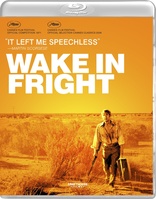
Movie rating
7.7 | / 10 |
Blu-ray rating
| Users | 5.0 | |
| Reviewer | 4.0 | |
| Overall | 4.0 |
Overview
Wake in Fright (1971)
Wake in Fright is the story of John Grant, a teacher who arrives in the outback mining town of Bundanyabba planning to stay overnight before catching the plane to Sydney. But a long detour of gambling, alcohol and brutality change Grant's plans.
Starring: Donald Pleasence, Gary Bond, Chips Rafferty, Sylvia Kay, Jack ThompsonDirector: Ted Kotcheff
| Drama | Uncertain |
| Thriller | Uncertain |
Specifications
Video
Video codec: MPEG-4 AVC
Video resolution: 1080p
Aspect ratio: 1.85:1
Original aspect ratio: 1.85:1
Audio
English: Dolby Digital 2.0 (192 kbps)
Advertised DTS-HD MA 2.0 is incorrect
Subtitles
English SDH
Discs
25GB Blu-ray Disc
Single disc (1 BD)
Playback
Region A (locked)
Review
Rating summary
| Movie | 4.5 | |
| Video | 4.0 | |
| Audio | 3.0 | |
| Extras | 4.0 | |
| Overall | 4.0 |
Wake in Fright Blu-ray Movie Review
Watch in Awe
Reviewed by Michael Reuben January 9, 2013The extraordinary history of Wake in Fright (hereafter, "WIF") is retold many times in this impressive package from Drafthouse Films, but let's summarize. The film was made by a Canadian director and a British producer, and co-financed internationally when the Australian film industry was in its infancy. Released in 1971, WIF bombed at the local box office, because Australian audiences were appalled at its frank portrayal of life in the outback. ("That's not us!" yelled one man at a screening attended by co-star Jack Thompson.) In the international market, the film's brutal depiction of one man's lost weekend of drinking, gambling and bloodsport did little better. Only the French embraced it (as they so often do with cinematic outcasts). Critics were favorable, and so were fledgling directors, including up-and-coming Australian auteurs like Peter Weir, Fred Schepisi and Bruce Beresford and a little-known American upstart named Martin Scorsese, who sat behind WIF's director at the Cannes Film Festival and exclaimed his approval audibly throughout the film's screening. As an éminence grise thirty-eight years later, Scorsese would bring the restored film back to Cannes as a classic. In the interim, though, the film was little seen, theatrically or on TV or video. Its negative disappeared into obscurity, the location unknown. In 1996, the film's editor, Anthony Buckley, began a search for the elements. Eight years and many false starts later, they were found in a Pittsburgh facility where they had been slated for destruction. Several years of legal disentanglement ensued, followed by additional years of tests and restoration work. The digitally restored film was released at the Cannes Film Festival in May 2009, in Australia theatrically the following month, and on DVD and Blu-ray shortly after. Drafthouse has acquired the rights to release it here.
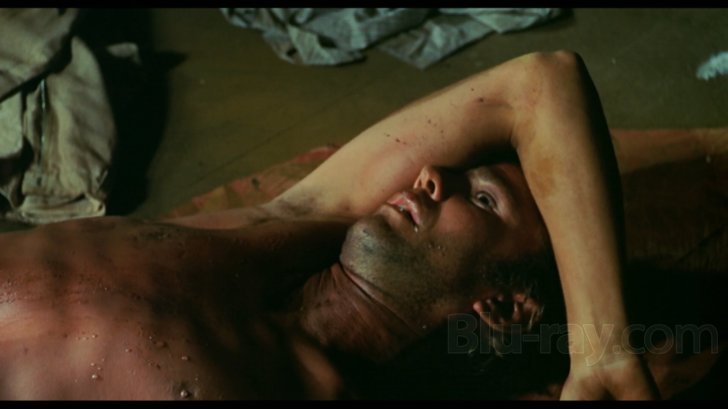
Author Kenneth Cook drew the title of his 1961 novel, Wake in Fright, from an old curse (or so he claimed): "May you dream of the devil and wake in fright." With an efficient script by Evan Ross (Funeral in Berlin) and supple direction by Ted Kotcheff (First Blood, among many others), WIF effectively creates the texture of a waking nightmare from which its anti-hero, John Grant (Gary Bond), cannot escape. It's easy to see why contemporary Australian audiences were shocked, because the arid outback and its hard-drinking inhabitants quickly emerge as essential elements of the lurid phantasmagoria that threatens Grant. What those viewers may have missed in their initial shock is that the outback is only half the equation. WIF is equally about Grant, an Englishman out of his native habitat, in whom the outback unleashes something unexpected, strange and violent. There are moments when it could be called Lord of the Flies Down Under. Other than the fact that he is English and a teacher, we learn almost nothing of Grant's background, which is essential to WIF. If we knew too much about him, the temptation to explain him away by some reference to personal history might be too hard to resist. For whatever reason, Grant came to Australia, but the State Education Board requires that teachers be "bonded", i.e., that they deposit $1000 dollars as a guarantee that they will fulfill their contract. As a result, Grant had no choice when he was assigned to a school in the remote outback town of Tiboonda. As the film opens, Grant bids farewell to his class and his landlord, the local pub owner, Charlie (John Meillon), before catching the train on the first leg of a Christmas holiday trip to Sydney. With minimal dialogue, Kotcheff's visuals and Bond's performance establish Grant's distaste for the surroundings in which his teaching contract has landed him. Grant is supposed to catch a plane from Bundanyabba, locally known as "The Yabba", a fictional town based on Broken Hill, New South Wales, where much of WIF was shot. After an overnight stay in The Yabba, Grant is looking forward to an interlude on a beach with a beautiful young woman of whom he has a photo (and who beckons in his imagination). But he never makes his plane. Grant's nightmare begins innocently enough when he steps out for a drink and is accosted by the local lawman, Jock Crawford (Australian film star Chips Rafferty in his final film). Simultaneously jovial, insinuating and condescending, Crawford adopts the stranger, buys him beer after beer and shows him the town. The biggest attraction is the local game of "two-up", a simple but addictive gamble involving a toss of two coins. Before long, Grant is part of the pushing, cheering crowd, with visions of a quick fortune to buy himself out of his "bonded" teacher's contract. Another new acquaintance is "Doc" Tydon (Donald Pleasance), a doctor without a license who says his profession is drinking. What Doc really does is a mystery, but he keeps turning up like an evil spirit. When a local named Tim Hynes (Al Thomas) brings Grant home for—what else?—more drinking, Doc appears as if it were the most natural thing. So do others, including a pair of miners looking to raise hell, Dick and Joe (Jack Thompson and Peter Whittle), who take Grant on a kangaroo hunt so brutal that WIF's director and producer felt obliged to run a disclaimer at the film's end. While all this is happening, Hynes's daughter, Janette (Sylvia Kay, the director's wife at the time), floats dolefully like a ghost in and out of the picture. There's no room for women in this alcoholic haze of male carousing. Grant is more than a passive victim of these misadventures. There may be an element of bullying in the aggressive directness with which each new acquaintance insists that Grant have a drink, but as he shows on several occasions, Grant knows how to say "no". His acquiescence is a choice. He has, after all, been living cheek by jowl with this same outback mentality in Tiboonda, but there Grant had a respectable image to maintain. Not so in The Yabba. Here, he's on vacation. To paraphrase a slogan that hadn't yet been invented, perhaps Grant senses that what happens in The Yabba stays in The Yabba, which gives him license to explore territory into which he'd never before dared to venture. What ultimately happens to Grant? Nothing simple or straightforward. The last act of WIF, after Grant tries to pick himself up and crawl back to civilization, grows increasingly surreal. Only in The Yabba would people see a man staggering along the sidewalk covered in blood and carrying a rifle, and not think too much of it.
Wake in Fright Blu-ray Movie, Video Quality 
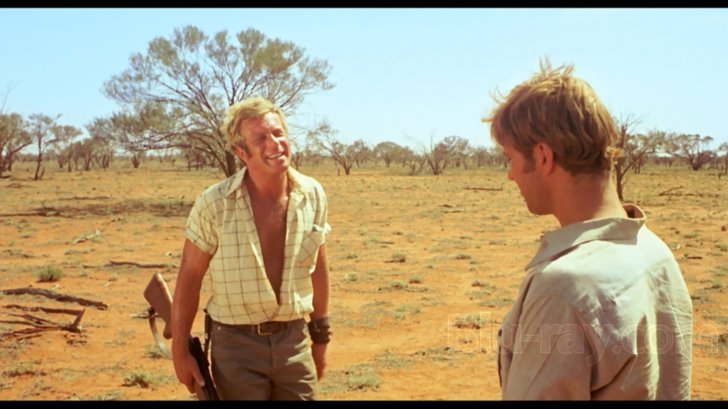
Prologue (added on May 20, 2015): In the two and a half years since this review was published, many posters at Blu-ray.com have expressed perplexity—and that's putting it mildly—at my failure to condemn the video for its smoothness and lack of grain. Many of these posters appear to be unaware of the interview with director Ted Kotcheff that appeared shortly after this review, in which these issues were expressly addressed. Leaving aside the arguments advanced below, which I still find persuasive, I find it compelling that the director of Wake in Fright considers the restoration of the film performed by Anthos Simon, then general manager of Deluxe Australia, to be the "best" the film has ever looked in both color fidelity and detail. As the director of numerous films, and also as the showrunner of Law and Order: SVU when it made the transition from film to HD video, Mr. Kotcheff is fully familiar with how film should look. He also has the perspective of having seen Wake in Fright when it was first released, which is an advantage not enjoyed by most critics of the current restoration. I have also seen references to "unrestored" stills, which I assume refers to the comparisons first made available on the Australian Blu-ray. One should bear in mind that a straight scan of the "unrestored" negative would have produced an image that was, for the most part, faded and that suffered from numerous tears and scratches. The current presentation of Wake in Fright, in all of its forms, is a reconstruction from a badly deteriorated OCN for which no preservation efforts had been made. That so much detail could be extracted at all is a miracle. As for the color scheme, people are entitled to their opinions, but when it comes to accuracy, especially in this case I defer to the director. Finally, it would no doubt have been possible to silence many of the critics by overlaying this restoration with a layer of "digital grain". Far too many Blu-ray fans are willing to accept such trickery as "film-like", when it is nothing more than the deliberate introduction of noise into an otherwise clear image. I'm just as happy that Mr. Santos didn't indulge in such a cheat. It's generally agreed that the transfer of Wake in Fright used by Drafthouse Films is identical to that appearing on the Blu-ray previously released in Australia. One could hardly expect otherwise, since Drafthouse has neither access to the elements nor the financial incentive to produce a new transfer. Let's start with the obvious positives. The image on Drafthouse's 1080p, AVC-encoded Blu-ray reflects an excellent balance of bright, colorful frames in daytime scenes and dark, properly graded shadows at night. Blacks are deep and solid where they should be, and contrast in the bright (very bright) heat of day is appropriately set to bring out depth without blowing out detail. Except for an early scene on the train, in which Grant is imagining his Sydney holiday, director Kotcheff stipulated that he wanted no cool colors in the film, and the transfer accurately reproduces the intended palette dominated by reds, browns, oranges and ochres. (The daytime sky, of course, remains naturally blue.) From here, the situation becomes more problematic. The Australian Blu-ray has been repeatedly criticized for excessive application of so-called "DNR", a term that, it should be recalled, stands for "digital noise reduction" but has come to be applied indiscriminately in numerous instances where posters on internet fora have found fault with a video transfer. In some instances the criticism is legitimately applied but inaptly named; in others, the criticism is simply wrong, reflecting lack of familiarity with the source, ignorance of relevant film technology or some other flaw at the viewer's end. WIF presents a unique problem, because there isn't a good "original" against which to compare the Blu-ray image. WIF was restored entirely in the digital domain, after extensive comparison tests revealed that a photochemical restoration would harvest substantially less detail. A sample comparison of a frame restored by each method is reproduced in the booklet included with the Blu-ray. Nothing in any of the restoration articles I have read indicates that a 1971 print, or any other vintage source, was used as a standard by the restoration team. Throughout their commentary, director Kotcheff and editor Buckley repeatedly point out areas of detail that they say have never previously been visible, including on release prints struck from the negative in 1971. Now, since the evil of so-called "DNR" is to strip away visible detail, what are we to make of a situation where the people who made the film say we're seeing more detail than we ever have before? The image on the Drafthouse disc is certainly soft and frequently smooth in a manner that may (but does not necessarily) indicate the application of noise reduction software or high frequency filtering. However, similar effects can also be created by selective color grading and manipulations of contrast, both of which have consciously been applied here. Certainly there's none of the "wax dummy" quality in faces associated with the heavy application of DNR. Faces shine from perspiration, but Kotcheff confirms in his commentary that this was deliberate and intended. A fair question can be asked as to whether detail from the initial image capture was sacrificed in digital post-processing for the sake of creating a "cleaner" final product deemed more pleasing by the restoration team. But how could that question ever be answered? One would require access to the raw scan, assuming it still exists in unmodified form. WIF was not restored by faceless technicians working at the behest of corporate bean counters. The work was performed under supervision of the Australian National Film and Sound Archive by top craftsmen who have proudly stood up and taken responsibility for their choices. The film's director and editor have signed off on their work. Though an occasional shot gave me pause, overall I found the results to be detailed and free of artifacts, and I have scored it accordingly. I anticipate dissent, but I think that people claiming "DNR" need to explain exactly what has been "DNR'd" out of the image in WIF, given the fact that much of what's currently there was never more than a latent possibility in the negative until this version. Ultimately, if one is a true purist, the real question raised by the Blu-ray of WIF is how to judge a restoration that shows you more than the original film. For the director's comments on the restoration, please see Blu-ray.com's interview, which can be found here.
Wake in Fright Blu-ray Movie, Audio Quality 

Contrary to the jacket copy, the audio is lossy DD 2.0, and it gets the job done, although the dynamic range is somewhat limited. Whether that would improve with lossless encoding is unclear, but I suspect that Drafthouse was not provided with a full-range source to encode. Grant's dialogue is perfectly clear, but the Australian accents of many of the supporting characters are sufficiently thick that you may need the aid of the subtitles. The sound editing of WIF is sophisticated, but not in the way we think of today. It uses intrusions of sound (odd volumes, sounds that don't belong, abrupt silences) to enhance Grant's sense of dislocation and the general air of unreality. The DD track conveys this effect adequately and also does a surprisingly good job with the soundtrack by pop musician John Scott.
Wake in Fright Blu-ray Movie, Special Features and Extras 
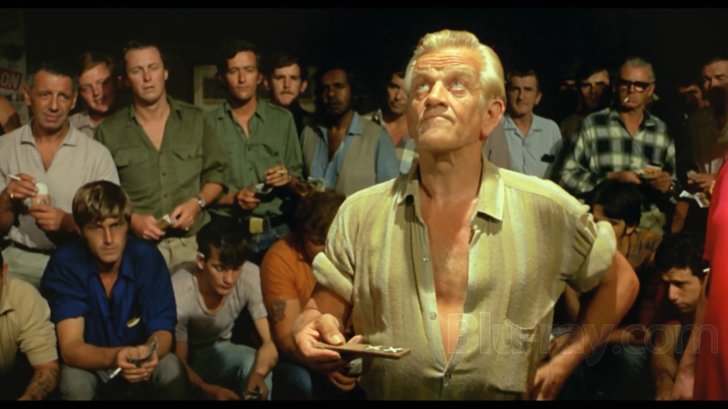
- Commentary with Director Ted Kotcheff and Editor Anthony Buckley: This commentary was recorded in 2009, shortly after the film's re-release. Much of Kotcheff's commentary consists of stories he retells elsewhere in the various featurettes, but he also recalls additional detail about the production as he watches individual scenes. Buckley does less talking, but he does comment on some of the practical challenges of editing the footage. Both director and editor repeatedly note areas of detail that have never before been visible.
- To "The Yabba" and Back: An Interview with Ted Kotcheff (480i; 1.78:1, enhanced; 12:45): This featurette grew out of an interview done by Mark Hartley for his rollicking documentary about the Australian film industry, Not Quite Hollywood (2008), which is unfortunately not available on Blu-ray in Region A.
- Q&A with Ted Kotcheff at the 2009 Toronto International Film Festival (480i; 1.78:1, enhanced; 45:52): With moderation by Martin Knelman, Kotcheff provides an overview of his career and a number of interesting stories and insights about the making of Wake in Fright. Much of the material duplicates To "The Yabba" and Back, but in greater depth.
- Who Needs Art?: Vintage Segment on Wake in Fright (480i; 1.33:1; 5:36): Created while the film was in production, this news report focuses on whether Wake in Fright is genuinely "Australian", given its Canadian director, English stars and international co-financing.
- Chips Rafferty's Obituary (480i; 1.33:1; 3:19): Rafferty died of a heart attack at age 61 on May 27, 1971, months before Wake in Fright opened in Australia. This TV obituary traces his career and offers tributes from colleagues.
- TV Spot: ABC's 7:30 Report on the Rediscovery and Restoration of the Film (480i; 1.78:1, enhanced; 6:23): A brief report on the film's recovery. Unfortunately, the information on restoration is too spotty and the comparison frames of too low quality to be truly useful.
- Trailers (1080p)
- Wake in Fright
- The Ambassador
- Bullhead
- Klown
- Miami Connection
- Drafthouse Alliance
- Booklet: In addition to stills and other illustrations, the booklet includes the following essays:
- Lost and Found, Anthony Buckley, August 2009: A detailed history of the search for WIF's negative and related materials.
- Restoring "Wake in Fright", Graham Shirley, Senior Curator, Moving Image, NFSA: As the title suggests, an overview of the restoration efforts.
- Rediscovering a Classic, Meg Labrum, Chief Curator, NFSA: A companion piece to Buckley's account and a plea for film preservation.
- Film Restoration, Anthos Simon, Film/Digital Restoration Manager, Atlab/Deluxe: Considering that Simon is the person who performed the lion's share of the restoration work, one might hope for something more than three brief paragraphs.
- Dreaming of the Devil, Peter Galvin, Sydney, Australia, September 2009: A lengthy and thoughtful consideration of the film, its sources and contemporary reactions to it.
Wake in Fright Blu-ray Movie, Overall Score and Recommendation 
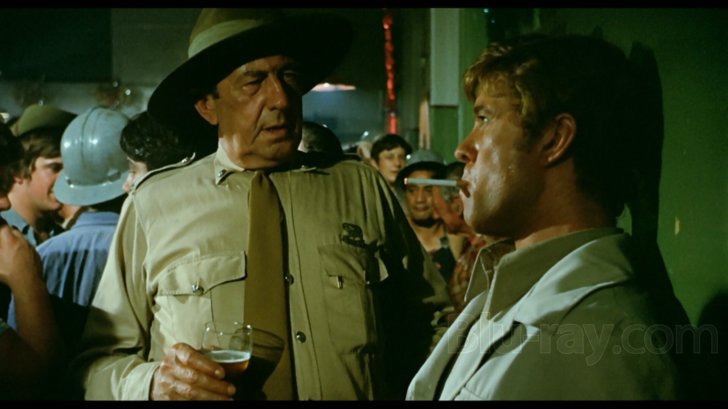
It would be unfortunate if debates over the restoration process overshadowed the film that has been rescued and restored. The restoration team has made its artistic choices, and what appears on this Blu-ray is how the film has been preserved for the ages. The alternative would have been to have it disappear for all time, thereby depriving the world of a unique and harrowing tale of a civilized man's systematic disassembly by . . . what exactly? That's the intriguing question that hangs over the end of WIF. What is it about the outback that proves so irresistibly alluring to someone like John Grant—or, for that matter, Doc Tydon, in whom Grant perhaps sees too much of himself for comfort? What makes Grant take a "bonded" position in a place he despises and then, as soon as he's offered the opportunity for an escape, fling himself more deeply into the same vile muck? A character flaw? Sun stroke? Original sin? WIF doesn't even give you a hint, and that's one of its most unsettling elements. Highly recommended.
Similar titles
Similar titles you might also like

The Man Who Fell to Earth
Limited Collector's Edition
1976

Strangerland
2015

Secret Sunshine
밀양 / Milyang
2007

Mustang
2015

Walkabout 4K
1971

Tom at the Farm
Tom à la ferme / English packaging / Version française
2013

Loveless
Нелюбовь / Nelyubov
2017

Young & Beautiful
Jeune et jolie / Slipcover in Original Pressing
2013

Swerve
2011

My Blueberry Nights
2007

Wrong Move
Falsche Bewegung
1975

Certain Women
2016

Looking for Mr. Goodbar 4K
Slipcover in Original Pressing
1977

The Club
El Club
2015

Straw Dogs
4K Restoration
1971

Woman in the Dunes
砂の女 / Suna no onna
1964

Nymphomaniac: Volume II
2013

Jauja
2014

Monos
2019

The Last Detail 4K
Shout Select
1973